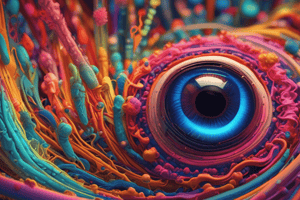Podcast
Questions and Answers
What is the purpose of convergence of photoreceptors onto retinal ganglion cells (RGCs) in the retina?
What is the purpose of convergence of photoreceptors onto retinal ganglion cells (RGCs) in the retina?
- To decrease the number of RGCs responding to light from a single point in the visual field
- To increase the overlap of receptive fields of RGCs
- To decrease the light sensitivity of RGCs receiving input from cones
- To increase the size of the receptive fields of RGCs (correct)
What is the difference in the response of on-center and off-center retinal ganglion cells (RGCs) to light in the center of their receptive fields?
What is the difference in the response of on-center and off-center retinal ganglion cells (RGCs) to light in the center of their receptive fields?
- On-center RGCs have smaller receptive fields than off-center RGCs
- On-center RGCs are turned on by light, while off-center RGCs are turned off by light (correct)
- On-center RGCs have antagonistic centers and surrounds, while off-center RGCs have non-antagonistic centers and surrounds
- On-center RGCs generate more action potentials in the dark, while off-center RGCs generate more action potentials in the light
What is the consequence of the overlapping receptive fields of retinal ganglion cells (RGCs)?
What is the consequence of the overlapping receptive fields of retinal ganglion cells (RGCs)?
- Light from one point in the visual field will affect many different RGCs (correct)
- Light from one point in the visual field will only affect a single RGC
- RGCs will have reduced light sensitivity
- RGCs will have larger receptive fields in the fovea compared to the periphery
What is the relationship between the convergence of photoreceptors onto retinal ganglion cells (RGCs) and the light sensitivity of RGCs?
What is the relationship between the convergence of photoreceptors onto retinal ganglion cells (RGCs) and the light sensitivity of RGCs?
What is the purpose of the antagonistic center-surround organization of the receptive fields of retinal ganglion cells (RGCs)?
What is the purpose of the antagonistic center-surround organization of the receptive fields of retinal ganglion cells (RGCs)?
Why are rods not functional in bright light?
Why are rods not functional in bright light?
What distinguishes the functionality of rods from cones in terms of light conditions?
What distinguishes the functionality of rods from cones in terms of light conditions?
Why don't we perceive colors in dim light according to the text?
Why don't we perceive colors in dim light according to the text?
What is the relationship between the receptive fields of RGCs and their location?
What is the relationship between the receptive fields of RGCs and their location?
In what kind of light conditions are cones more functional compared to rods?
In what kind of light conditions are cones more functional compared to rods?
What is one reason why rods are more light sensitive than cones?
What is one reason why rods are more light sensitive than cones?
What is the main difference between rhodopsin in rods and coneopsin in cones?
What is the main difference between rhodopsin in rods and coneopsin in cones?
Why do rods have a larger surface area to absorb light compared to cones?
Why do rods have a larger surface area to absorb light compared to cones?
In what aspect do red coneopsins from different versions of the gene differ?
In what aspect do red coneopsins from different versions of the gene differ?
Why do rods absorb more light than cones?
Why do rods absorb more light than cones?
What is the mechanism for the formation of the visuotopic map in the superior colliculus?
What is the mechanism for the formation of the visuotopic map in the superior colliculus?
What is the consequence of the axons from RGCs in either eye that are activated by light from the same object converging on the same neurons in the superior colliculus?
What is the consequence of the axons from RGCs in either eye that are activated by light from the same object converging on the same neurons in the superior colliculus?
What is the reason why light from objects in the extreme periphery of the visual field (A and F) to the contralateral eyes is blocked by the nose?
What is the reason why light from objects in the extreme periphery of the visual field (A and F) to the contralateral eyes is blocked by the nose?
What is the relationship between the location of retinal ganglion cells (RGCs) and their receptive fields?
What is the relationship between the location of retinal ganglion cells (RGCs) and their receptive fields?
What is the purpose of the convergence of photoreceptors onto retinal ganglion cells (RGCs) in the retina?
What is the purpose of the convergence of photoreceptors onto retinal ganglion cells (RGCs) in the retina?
What is the relationship between the receptive fields of on-center and off-center retinal ganglion cells (RGCs) and their response to light in the center of their receptive fields?
What is the relationship between the receptive fields of on-center and off-center retinal ganglion cells (RGCs) and their response to light in the center of their receptive fields?
What is the consequence of the overlapping receptive fields of retinal ganglion cells (RGCs)?
What is the consequence of the overlapping receptive fields of retinal ganglion cells (RGCs)?
What is the consequence of less convergence of photoreceptors onto retinal ganglion cells (RGCs) in the fovea compared to the periphery of the retina?
What is the consequence of less convergence of photoreceptors onto retinal ganglion cells (RGCs) in the fovea compared to the periphery of the retina?
Which of the following statements accurately describes the relationship between convergence of photoreceptors onto RGCs and light sensitivity?
Which of the following statements accurately describes the relationship between convergence of photoreceptors onto RGCs and light sensitivity?
What is the primary reason for the antagonistic center-surround organization of the receptive fields of RGCs?
What is the primary reason for the antagonistic center-surround organization of the receptive fields of RGCs?
How do on-center and off-center RGCs differ in their response to light in the center of their receptive fields?
How do on-center and off-center RGCs differ in their response to light in the center of their receptive fields?
What is the consequence of the overlapping receptive fields of RGCs?
What is the consequence of the overlapping receptive fields of RGCs?
What is the primary function of convergence, where many photoreceptors converge onto a single retinal ganglion cell (RGC)?
What is the primary function of convergence, where many photoreceptors converge onto a single retinal ganglion cell (RGC)?
How does the release of neurotransmitters from photoreceptors affect the membrane potential of bipolar cells in the retina?
How does the release of neurotransmitters from photoreceptors affect the membrane potential of bipolar cells in the retina?
What is the primary function of the center-surround organization of retinal ganglion cell (RGC) receptive fields?
What is the primary function of the center-surround organization of retinal ganglion cell (RGC) receptive fields?
What is the primary reason for the differences in receptive field sizes of retinal ganglion cells (RGCs) across the retina?
What is the primary reason for the differences in receptive field sizes of retinal ganglion cells (RGCs) across the retina?
What is the primary mechanism underlying the antagonistic center-surround organization of retinal ganglion cell (RGC) receptive fields?
What is the primary mechanism underlying the antagonistic center-surround organization of retinal ganglion cell (RGC) receptive fields?
What is the primary function of the center-surround organization of the receptive fields of retinal ganglion cells (RGCs)?
What is the primary function of the center-surround organization of the receptive fields of retinal ganglion cells (RGCs)?
What is the primary mechanism by which the convergence of photoreceptors onto retinal ganglion cells (RGCs) enhances visual sensitivity?
What is the primary mechanism by which the convergence of photoreceptors onto retinal ganglion cells (RGCs) enhances visual sensitivity?
Which of the following best describes the relationship between the hyperpolarization and depolarization of retinal ganglion cells (RGCs) and their response to light?
Which of the following best describes the relationship between the hyperpolarization and depolarization of retinal ganglion cells (RGCs) and their response to light?
What is the primary reason for the difference in the size of receptive fields between retinal ganglion cells (RGCs) located in the fovea and those located in the periphery?
What is the primary reason for the difference in the size of receptive fields between retinal ganglion cells (RGCs) located in the fovea and those located in the periphery?
How does the convergence of photoreceptors onto retinal ganglion cells (RGCs) affect the release of neurotransmitters from RGCs?
How does the convergence of photoreceptors onto retinal ganglion cells (RGCs) affect the release of neurotransmitters from RGCs?
Flashcards are hidden until you start studying




